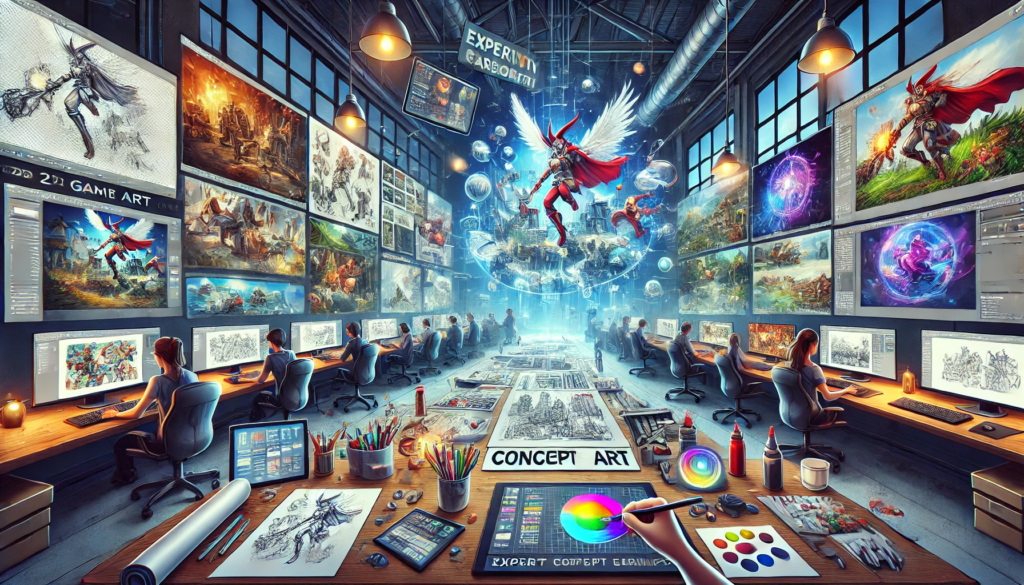Specialized concept art services are vital for 2D game development studios. This strategy improves creativity and operational efficiency by providing access to a global talent pool and streamlining production. High-quality, unique art assets are essential for success in today’s competitive gaming market.
Outsourcing art creation offers access to diverse talent and allows studios to remain agile in the dynamic gaming market. This approach benefits both established studios and emerging developers, enabling the creation of unique gaming experiences.
Accessing Specialized Talent
Diverse Skill Sets and Artistic Styles
2D game art outsourcing provides access to diverse artists with specialized skills and unique artistic styles.
- Specialization in Techniques: Studios select artists with diverse skills, ranging from pixel art and vector graphics to traditional hand-drawn illustrations, guaranteeing high-quality results that precisely meet project needs.
- Variety of Artistic Influences: Global outsourcing significantly enhances game design by integrating diverse cultural perspectives. Artists worldwide contribute unique cultural elements, storytelling techniques, and artistic styles, resulting in rich, multifaceted visual narratives with broad international appeal.
Staying Current with Trends
Outsourcing enables studios to stay ahead of industry trends by collaborating with artists actively engaged in the gaming community.
- Awareness of Emerging Styles: The dynamic gaming industry demands continuous adaptation to evolving trends and player preferences. Outsourcing partnerships provide studios access to artists deeply integrated into global gaming communities, ensuring market relevance and injecting fresh perspectives into their projects.
- Incorporation of New Technologies: Numerous concept art studios utilize state-of-the-art software and innovative artistic methods to produce high-quality 2D game art assets. These studios frequently showcase highly detailed textures, intricate designs, and visually stunning effects, exceeding typical expectations for 2D game visuals.
Creative Vision Enhancement
Broader Perspectives
External art studios bring fresh perspectives to game development projects.
- Cross-Pollination of Ideas: Diverse teams encourage dynamic brainstorming, which can result in innovative artistic directions and more engaging visuals. This external viewpoint can transform standard game elements into unique features that capture player attention.
- Challenging Conventional Thinking: Their artists often challenge conventional thinking, leading to innovative solutions and creative breakthroughs.
Increased Imagination and Concept Development
The collaboration between in-house teams and outsourced artists creates valuable opportunities for concept exploration. Multiple iterations of character designs and environments can be developed simultaneously, allowing for thorough, creative exploration before finalizing designs. This iterative process helps refine ideas while ensuring alignment with the game’s vision.
Operational Efficiency
Streamlined Production Processes
Outsourcing art production allows internal teams to focus on core development tasks such as programming and gameplay mechanics. Specialized art studios maintain established workflows that expedite asset creation without compromising quality. While in-house teams work on technical aspects, outsourced teams handle art production, minimizing delays and maintaining momentum.
Flexibility and Scalability
This efficiency proves crucial in an industry where timely releases significantly impact success.
The ability to scale resources according to project demands represents another key advantage. Game development often involves fluctuating workloads, and outsourcing enables studios to adjust their art team size without long-term commitments. By outsourcing, studios save on overhead costs, such as salaries, benefits, and infrastructure, reallocating resources to other critical areas of development. This flexibility helps manage peak production phases while maintaining cost efficiency.
Risk Management and Quality Assurance
Working with established art studios reduces risks associated with project delays and quality issues. Professional outsourcing partners understand industry standards and deadlines, minimizing the likelihood of complications. Additionally, distributing work across multiple teams reduces dependency on any single group, creating a more robust development process.
Technological Integration
Professional art studios often utilize cutting-edge tools and software for creating game assets. This access to advanced technology enables the production of highly detailed and polished visuals.
High-End Software: Tools like Adobe Creative Suite or Clip Studio Paint enable detailed and visually stunning art assets.
Innovation Through Technology: Outsourcing partners often pioneer new techniques and tools, introducing unique styles and methodologies that enhance a game’s visual storytelling. Studios can explore new artistic styles and methodologies that enhance their games’ visual storytelling capabilities.
Long-term Partnership Benefits
Sustained collaborations with art studios often lead to valuable long-term partnerships. Consistent Quality Over Time: These relationships foster consistent quality across multiple projects as partners develop deeper understandings of each other’s creative visions and workflows.
Shared Vision Development: Such partnerships often result in more efficient collaboration and higher-quality outputs over time.
Conclusion
Outsourcing 2D game art represents a strategic approach combining creative excellence and operational efficiency. Access to specialized talent, broader creative perspectives, streamlined production processes, risk mitigation, advanced technologies, and long-term partnerships collectively empower developers to deliver visually compelling games while optimizing resource allocation.
As the gaming industry continues to evolve, this model provides studios the flexibility and resources needed to create visually stunning games while maintaining a competitive advantage in a rapidly changing market.
FAQs
1. How does outsourcing art production affect game development timelines?
Professional art studios typically maintain efficient workflows that can accelerate asset creation while maintaining quality standards, potentially reducing overall development time.
2. What types of games benefit most from outsourced art services?
Any game project can benefit, but those requiring specialized art styles, large amounts of content, or unique visual elements often see the greatest advantages from outsourcing.
3. How do studios maintain creative control when outsourcing art?
Through clear communication channels, detailed art direction documents, and regular feedback sessions, studios can maintain creative control while benefiting from external expertise.
4. What cost considerations should studios consider when outsourcing?
Studios should evaluate hourly rates, project-based pricing, revision policies, and potential long-term partnership discounts while comparing these costs to maintaining an internal art team.
5. How do cultural differences impact outsourced art production?
Cultural diversity often enriches creative output by introducing unique perspectives and artistic styles, though studios should establish clear communication protocols to prevent misunderstandings.
6. What role does technology play in successful art outsourcing?
Modern collaboration tools, asset management systems, and communication platforms enable seamless interaction between internal teams and external artists, ensuring efficient workflow management.



